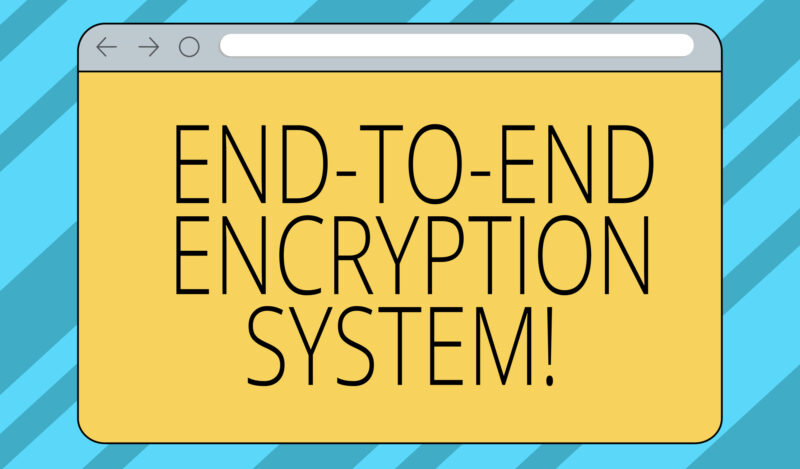
La crittografia end-to-end è solo una delle diverse tipologie di crittografia oggi esistenti.
La cifratura è infatti una tecnica molto antica che si è evoluta nel tempo, presentandosi oggi sotto diverse forme e offrendo un’ampia gamma di preziosi vantaggi.
Primo tra tutti la protezione dei dati, una pratica decisamente prioritaria che non può mancare nel piano di sicurezza delineato da qualsiasi azienda.
I Big Data hanno infatti un valore incalcolabile e tutelare la privacy delle informazioni è utile e importante.
Per questo la crittografia è uno strumento fondamentale che si rinnova in continuazione, cercando di proporre nuove funzionalità e di restare al passo con i cambiamenti tecnologici.
Indice dei contenuti
Cos’è la crittografia end-to-end?
Per spiegare meglio cosa si intende per crittografia end-to-end, è utile partire dal concetto generale di crittografia e capire di cosa si tratta.
La crittografia, termine di origine greca che significa scrittura segreta, è una tecnica antica con cui rendere le informazioni illeggibili e decifrabili solo grazie a una chiave di lettura.
È uno strumento di tutela dei dati importantissimo che negli anni si è evoluto diventando uno strumento fondamentale per la Cyber Security.
Si basa su degli algoritmi matematici che sostituiscono gli elementi di un testo con altri elementi riorganizzati secondo precisi spostamenti, facendo attenzione a non perdere alcun elemento durante il procedimento.
Il testo diventa così decifrabile solo da chi è in possesso della chiave di codifica, e quindi autorizzato ad accedere alle informazioni.
Esistono diversi tipi di crittografia e tra le più moderne c’è la crittografia end-to-end, che letteralmente significa dall’inizio alla fine.
Questa particolare cifratura consente di proteggere le comunicazioni creando una sorta di schermo crittografico adatto a nasconderle.
Con questo sistema il messaggio è accessibile solo al mittente e al destinatario, mentre hacker e malintenzionati si troveranno di fronte a combinazioni alfanumeriche indecifrabili: da qui il significato del nome, che indica una comunicazione esclusiva che non coinvolge terze parti.
Ciò che la contraddistingue dagli altri tipi di crittografia è che la chiavi private utilizzate non sono create direttamente da chi gestisce il canale di comunicazione, ma sono generate e archiviate direttamente dai device di chi sta comunicando.
Come funziona la crittografia end-to-end
La crittografia end-to-end si basa sull’uso di due differenti chiavi di codifica: una chiave pubblica e una chiave privata correlate tra loro.
Le chiavi si generano nel momento in cui due dispositivi iniziano uno scambio di messaggi, creando un canale comunicativo invisibile ma che deve essere protetto.
Le chiavi rimangono sui rispettivi dispositivi e nemmeno chi gestisce il canale comunicativo può accedervi: inviando un messaggio il server della piattaforma lo riceve per poi indirizzarlo al destinatario, ma non può decifrarlo e leggerlo.
Ed è proprio questo il concetto su cui si fonda la crittografia end-to-end, rendendo i messaggi visibili solo sul proprio terminale e su quello del ricevente e assicurando così che il server non registri o condivida i dati con nessuno e per nessun motivo.
In questo modo la conversazione risulta essere impenetrabile a malintenzionati e hacker, beneficiando di messaggi leggibili solo da chi effettivamente ne ha l’autorizzazione.
Il meccanismo è automatico e si attiva nel momento stesso in cui si comincia a usare una piattaforma di messaggistica, non c’è quindi bisogna di attivare particolari impostazioni.

Un caso noto a tutti: WhatsApp
La crittografia end-to-end ha cominciato ad essere globalmente nota nel 2016, quando la piattaforma di messaggistica istantanea WhatsApp l’ha introdotta per proteggere i messaggi dei propri utenti.
Nel momento in cui si inizia una conversazione sull’app, infatti, appare una scritta che indica che i messaggi sono criptati grazie alla crittografia end-to-end e pertanto accessibili solo agli attori coinvolti.
Nemmeno i gestori di reti di telecomunicazione o gli Internet Service Provider possono spiarli, alterarli, registrarli o condividerli con altri.
La scelta di WhatsApp di adottare questa tecnologia è dovuta alla grande attenzione che riservano alla privacy, premurandosi non solo di tutelare i messaggi, ma anche foto, video, documenti, messaggi vocali, aggiornamenti dello stato, telefonate e videochiamate.
L’impostazione si attiva di default e riguarda le conversazioni di tutti gli utenti dell’applicazione.
I limiti di questa tecnologia
Quali sono, però, le difficoltà e i problemi a cui si va incontro affidandosi a questa tecnologia?
Innanzitutto bisogna tenere a mente che per quanto la crittografia end-to-end sia sicura e innovativa, non è comunque infallibile.
Le conversazioni sono criptate e indecifrabili, ma gli hacker possono accedervi lo stesso in maniera indiretta e trovando altri espedienti.
Per esempio si può fare leva su tecniche di social engineering e accedere così all’account di archiviazione online in cui è salvato il backup delle conversazioni dell’utente.
Oppure si può infettare un device con un particolare virus chiamato keylogger, che registra gli input inseriti attraverso la tastiera.
In più c’è da considerare che nonostante il contenuto dei messaggi sia cifrato, il server è comunque consapevoleche tra determinati utenti è avvenuta una comunicazione, attirando in certi casi un’attenzione indesiderata.
Desideri parlare con un nostro esperto? Contattaci
Ultime News Concetti di sicurezza informatica
-

-

Ransomware: gestione avanzata, tendenze e futuro
16 Maggio 2024 -

Strategie avanzate contro il malware
2 Maggio 2024 -

Come prevenire, rilevare e analizzare il malware
29 Aprile 2024 -

Pharming: Cos’è, Tipologie e Come prevenirlo
21 Dicembre 2023 -

Phishing: cos’è e come prevenirlo
23 Ottobre 2023 -

La Cybersecurity prevista dall’UE: Direttiva NIS e Cybersecurity Act
26 Settembre 2023 -

Crittografia simmetrica e asimmetrica: significato e differenze
7 Settembre 2023 -

Differenza tra phishing, smishing e vishing
10 Agosto 2023 -

Sicurezza informatica e cybersecurity
-

NIS2, cos’è e come inserire la direttiva in azienda
7 Giugno 2024 -

-

Come implementare il penetration test?
6 Aprile 2024 -

-

-

-

Cos’è un Ransomware, come si prende e come proteggersi
28 Aprile 2023 -

Che cos’è un malware e come affrontarlo?
24 Aprile 2023 -

-






















